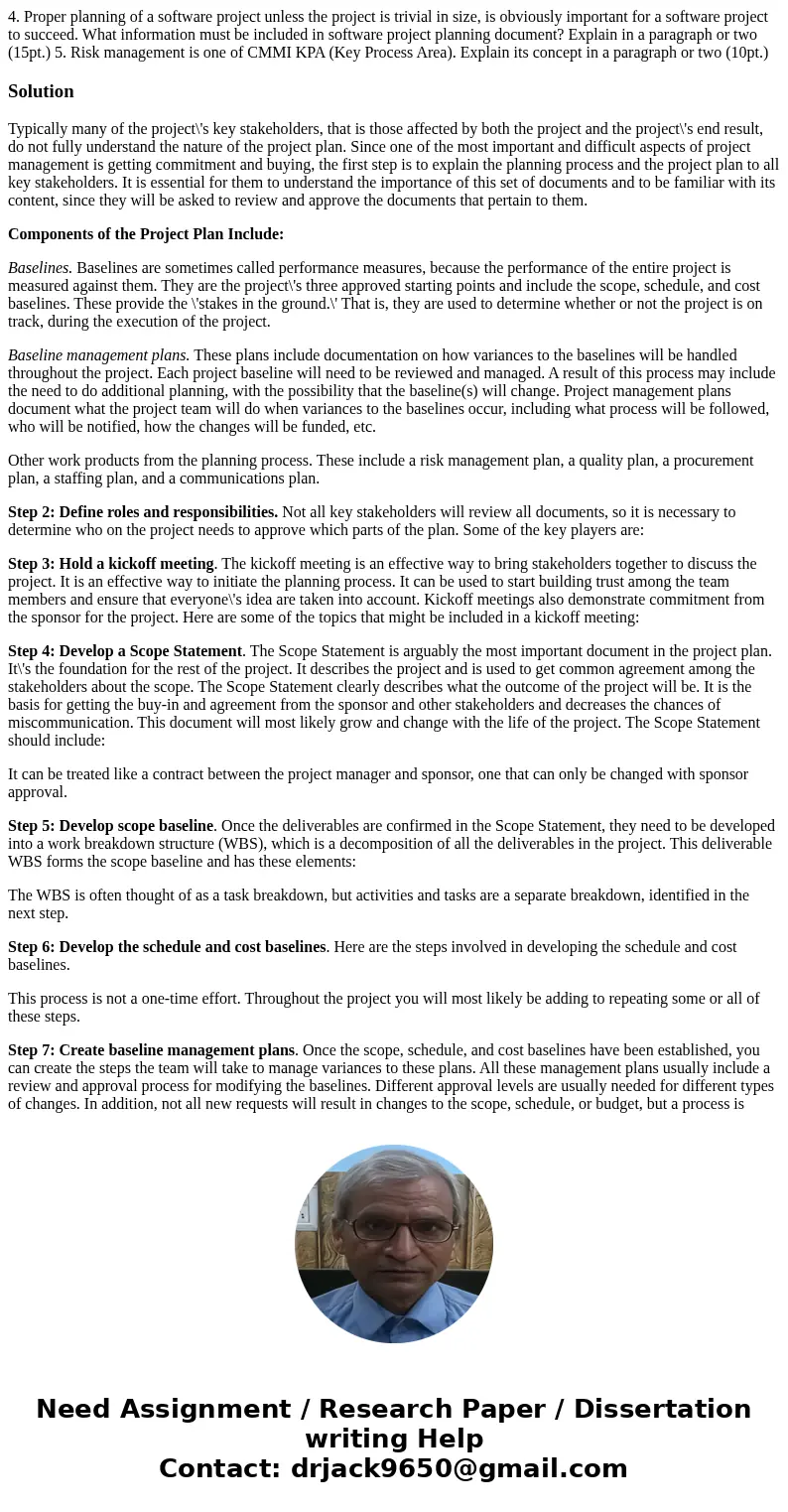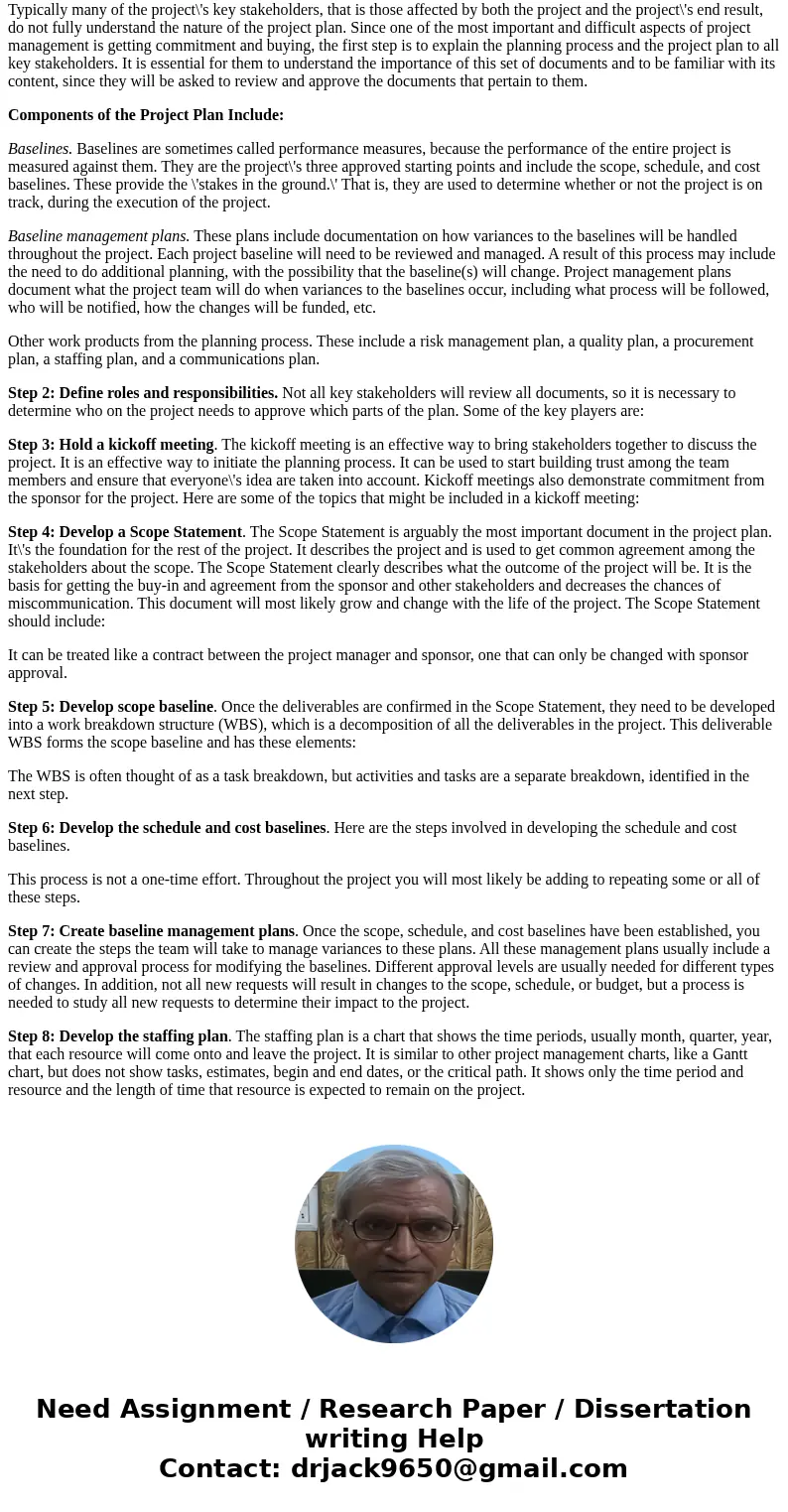4 Proper planning of a software project unless the project i
Solution
Typically many of the project\'s key stakeholders, that is those affected by both the project and the project\'s end result, do not fully understand the nature of the project plan. Since one of the most important and difficult aspects of project management is getting commitment and buying, the first step is to explain the planning process and the project plan to all key stakeholders. It is essential for them to understand the importance of this set of documents and to be familiar with its content, since they will be asked to review and approve the documents that pertain to them.
Components of the Project Plan Include:
Baselines. Baselines are sometimes called performance measures, because the performance of the entire project is measured against them. They are the project\'s three approved starting points and include the scope, schedule, and cost baselines. These provide the \'stakes in the ground.\' That is, they are used to determine whether or not the project is on track, during the execution of the project.
Baseline management plans. These plans include documentation on how variances to the baselines will be handled throughout the project. Each project baseline will need to be reviewed and managed. A result of this process may include the need to do additional planning, with the possibility that the baseline(s) will change. Project management plans document what the project team will do when variances to the baselines occur, including what process will be followed, who will be notified, how the changes will be funded, etc.
Other work products from the planning process. These include a risk management plan, a quality plan, a procurement plan, a staffing plan, and a communications plan.
Step 2: Define roles and responsibilities. Not all key stakeholders will review all documents, so it is necessary to determine who on the project needs to approve which parts of the plan. Some of the key players are:
Step 3: Hold a kickoff meeting. The kickoff meeting is an effective way to bring stakeholders together to discuss the project. It is an effective way to initiate the planning process. It can be used to start building trust among the team members and ensure that everyone\'s idea are taken into account. Kickoff meetings also demonstrate commitment from the sponsor for the project. Here are some of the topics that might be included in a kickoff meeting:
Step 4: Develop a Scope Statement. The Scope Statement is arguably the most important document in the project plan. It\'s the foundation for the rest of the project. It describes the project and is used to get common agreement among the stakeholders about the scope. The Scope Statement clearly describes what the outcome of the project will be. It is the basis for getting the buy-in and agreement from the sponsor and other stakeholders and decreases the chances of miscommunication. This document will most likely grow and change with the life of the project. The Scope Statement should include:
It can be treated like a contract between the project manager and sponsor, one that can only be changed with sponsor approval.
Step 5: Develop scope baseline. Once the deliverables are confirmed in the Scope Statement, they need to be developed into a work breakdown structure (WBS), which is a decomposition of all the deliverables in the project. This deliverable WBS forms the scope baseline and has these elements:
The WBS is often thought of as a task breakdown, but activities and tasks are a separate breakdown, identified in the next step.
Step 6: Develop the schedule and cost baselines. Here are the steps involved in developing the schedule and cost baselines.
This process is not a one-time effort. Throughout the project you will most likely be adding to repeating some or all of these steps.
Step 7: Create baseline management plans. Once the scope, schedule, and cost baselines have been established, you can create the steps the team will take to manage variances to these plans. All these management plans usually include a review and approval process for modifying the baselines. Different approval levels are usually needed for different types of changes. In addition, not all new requests will result in changes to the scope, schedule, or budget, but a process is needed to study all new requests to determine their impact to the project.
Step 8: Develop the staffing plan. The staffing plan is a chart that shows the time periods, usually month, quarter, year, that each resource will come onto and leave the project. It is similar to other project management charts, like a Gantt chart, but does not show tasks, estimates, begin and end dates, or the critical path. It shows only the time period and resource and the length of time that resource is expected to remain on the project.


 Homework Sourse
Homework Sourse